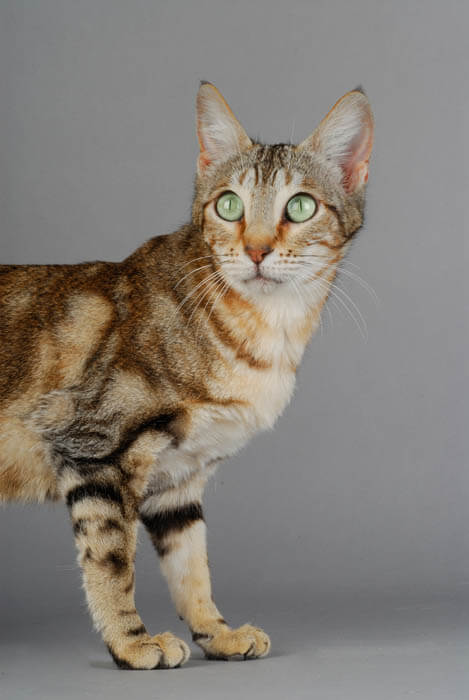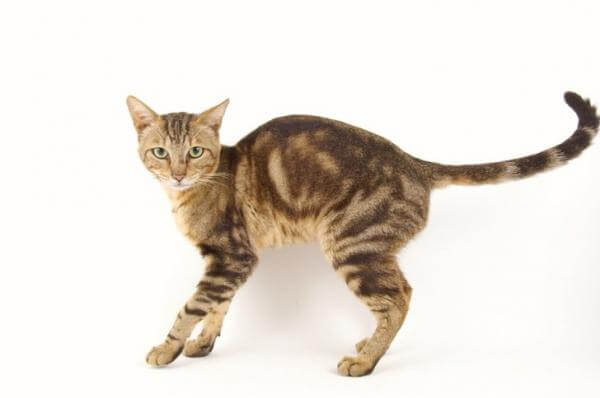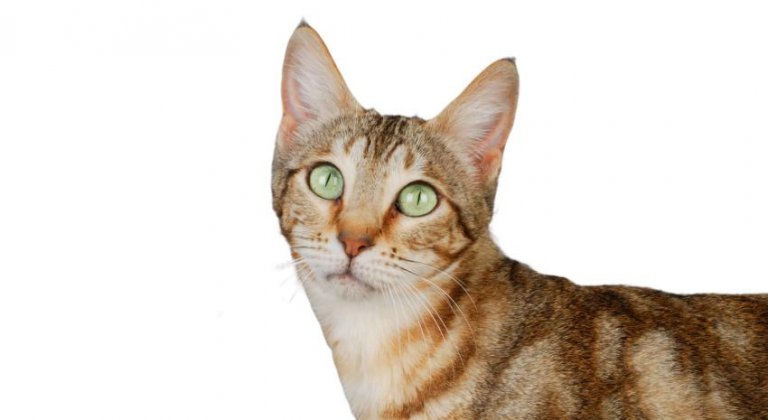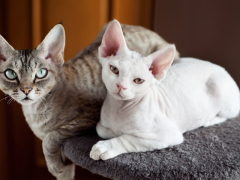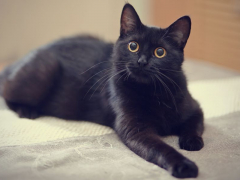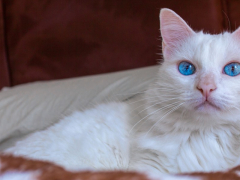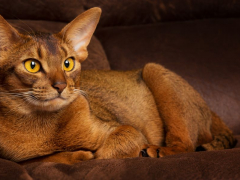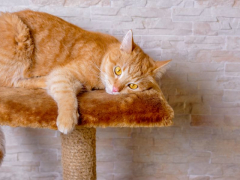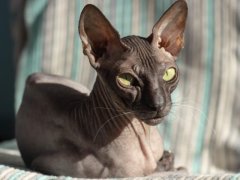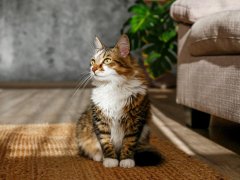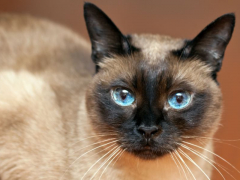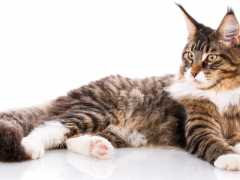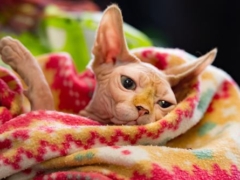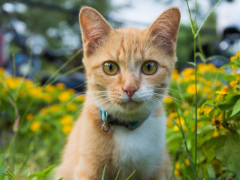Personality and Temperament
Also known as the Sokoke Forest cat or the African Shorthair, the Sokoke is an exotic-looking breed that originated in Eastern Kenya. A striking coat, a friendly personality, and a fondness for conversation makes this unique breed one to consider. If you’re looking for a cuddly, cozy companion, you might find the Sokoke cat a bit aloof. These cats do enjoy human companionship, but only on their terms. They have a marked distaste for being picked up and snuggled; instead, they prefer to follow their family members around, sometimes opting to rest alongside a favorite person during downtime.
Sokoke Forest cats are accomplished athletes, with a fondness for active pursuits. Cupboards and drawers don’t present much of an obstacle to the Sokoke, making cat-proofing well worth the effort. Since these cats like water, it’s important to secure aquariums well, too. Any small item can become a toy for this curious kitty, so it’s important to keep important objects secured or risk having them chewed and clawed into oblivion.
Speaking of claws, this cat isn’t afraid to lash out when threatened or disrespected. While Sokoke cats can make lifelong friends with kids, other felines, and respectful dogs, they are a touch less tolerant than most, making careful introductions even more important than usual.
Despite this kitty’s insistence on respect, most individuals love everyone and when well-socialized, will even greet strangers at the door. When family members return from a long day at work, the Sokoke is usually right there to say hello and have a chat about everything that happened during their human’s absence.
Because Sokoke cats originated in a warm climate and have low cold tolerance, these kitties do best with families that also appreciate warmth. They can develop tolerance for cool temperatures, but prefer to keep cozy. They are not well-suited to life outdoors.
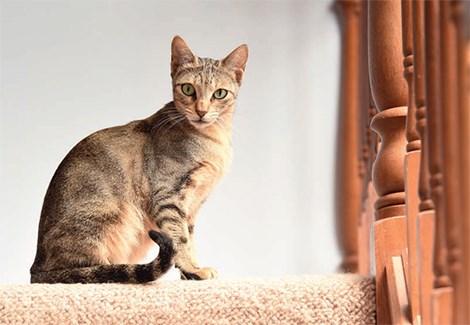
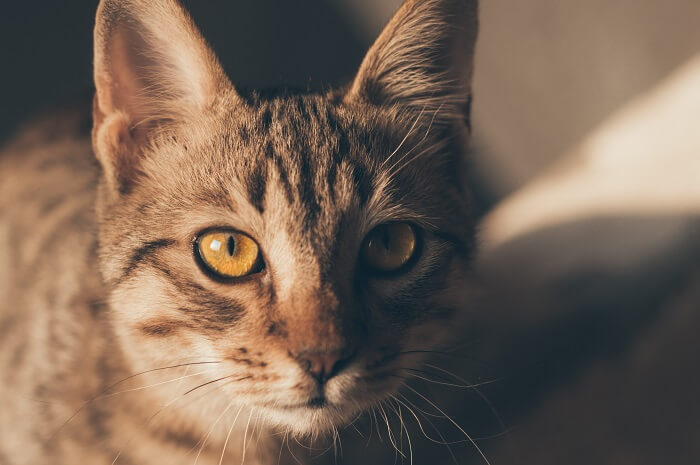
Care
Nutrition
Grooming
Exercise
Health
Even though Sokoke cats have no special nutritional needs, they thrive on a high-quality diet. If you’re not feeding fresh food, look for a brand that provides ample protein and few carbohydrates. Ensure that real meat or fish – not a filler – is the main ingredient. In addition, ensure that you’re feeding food that’s appropriate for your cat’s life stage.
The Sokoke cat has a very short, low-shedding coat, and does not require much at all in terms of grooming. As they dislike much handling, you might be best off putting your grooming efforts toward toenail trims and toothbrushing rather than brushing.
Teach your cat how to be handled from a young age and these routines won’t present quite so much of a challenge when your kitty reaches adulthood.
You probably won’t have to encourage your Sokoke cat to exercise! These kitties are powerful jumpers and capable climbers; and when it comes to running, they’re certifiable speed demons. A strong cat condo with platforms and at least one cave will be appreciated, and scratching posts can help save your furniture.
Offer your cat lots of toys and swap them out frequently to prevent boredom. As Sokoke cats can be very hard on their toys, keep an eye out for broken or excessively worn parts and discard those before anything harmful ends up in your pet’s digestive tract.
Sokoke cats have a reputation for enjoying robust good health, and to date, there are no known genetic issues with the breed. They are more vulnerable to contagious diseases than most other cats are, as they have little to no built-in resistance to common diseases that affect domestic cats. It’s very important to provide routine vaccinations and regular checkups, and to prevent contact between Sokoke cats and unvaccinated felines.
History
In 1977, wildlife artist Jeni Slater found a cat and kittens living near the edge of a forest on a tract of land her family owned in Kenya’s eastern Sokoke district. She eventually took two kittens: A male and a female, and from these two, a new cat breed was formed.
Because the cats she found had such unusual markings, Slater believed that they might be wildcats, although other theories suggest that the queen might have been a cross between a domestic cat and a wildcat, or that the cat might have had a genetic mutation that led to her unique appearance. Another theory – and the most probably – is that the foundation cats were feral khadzonzo cats, which are naturally occurring domestic cats.
In 1978, Slater began her breeding program in earnest, using cats from the Watamu area. Some were obtained as kittens, and others were adult feral cats that she tamed with the help of food rewards. The Sokoke cat breeding program was expanded in 1983, when Gloria Moeldrop brought a pair of Slater’s cats to Denmark. These cats were shown beginning in 1984.
In 1987, Slater brought in another cat to enhance genetic diversity. This time, it was a darker-colored street cat, also from Watamu. It is possible that the lynx point pattern seen in some Sokoke cats originated with this individual.
The Denmark breeding program expanded in 1989, with the addition of more cats from Kenya. Around the same time, Jeni Slater provided foundation stock to an Italian breeder named Bob Schwartz.
Later, Jeannie Knocker, an English citizen who lived near Slater in Kenya, decided to gather more feral cats from the Sokoke forest area. These produced litters that were eventually exported to Europe and the United States. With these cats came a new line of Sokoke cats, with distinct differences from those from Slater’s breeding line. It is possible that other breeds contributed to today’s Sokoke cats, however no one knows for certain.
Federation Intternationale Feline (FIFe) granted Sokoke cats official registration in 1993. To date, the only other registries that recognize Sokoke cats are The International Cat Association (TICA), the Canadian Cat Association (CCA), and the UK Governing Council of the Cat Fancy (GCCF).
